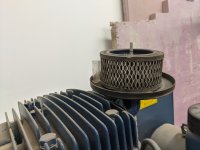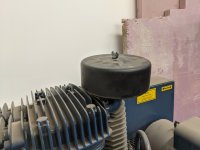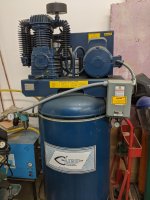You are using an out of date browser. It may not display this or other websites correctly.
You should upgrade or use an alternative browser.
You should upgrade or use an alternative browser.
Noise Insulation for shop compressor?
- Thread starter dragoneggs
- Start date
- Views: 24253
More options
Who Replied?
/ Noise Insulation for shop compressor?
#111
dragoneggs
Super Star Member
- Joined
- Jun 9, 2013
- Messages
- 14,548
- Location
- Seabeck, Washington
- Tractor
- Kubota BX-25D, Kubota Z122RKW-42
Yep... look at Volts x amps/745 for more accurate Hp number.Also, air compressor manufacturers have been caught stretching the truth. My Cambell Hausfeld 6 Horsepower / 60 Gallon compressor is actually only 3.4 Horsepower. Beware of Lies!
radios1
Elite Member
it was probably 6HP. PEAK. NOT Average.. like when the motor is stopped very quickly after it gets to full speed!..Companies sure know how to troll for Suckers. Sears also nailed me on a 6hp Shop Vac about 20 years ago. It couldn't have been over a 1hp. Still using it with a "Dust Deputy" in the garage.
BukitCase
Elite Member
- Joined
- Feb 17, 2012
- Messages
- 2,756
- Location
- Albany OR
- Tractor
- Case 580B, Long 460, Allis-Chalmers 160
" look at Volts x amps/745 for more accurate Hp number"
Mark, a MINOR "nit pick" - 1 electrical horsepower is 745.7 watts :laughing:
Also, using that formula only tells you how much horsepower you're INPUTTING; one example - the 5 horse industrial compressor I linked to previously in this thread, uses 21.5 amps @ 240 volts: so it's INPUT power works out to just over 6.9 horsepower. Works out to just over 72% efficiency, IF that Baldor motor's only putting out a REAL 5 horsepower.
And no, I'm NOT gonna hook it up to a rope/pulley/weight and see if it can lift a 550 lb weight more than 5 feet per second :laughing:
Attention Required! | Cloudflare
radios1 - I've seen little 120 volt vertical "roll-around" compressors marked 6 horsepower; pretty sure they used locked rotor amps to calculate THAT lie ... Steve
... Steve
Mark, a MINOR "nit pick" - 1 electrical horsepower is 745.7 watts :laughing:
Also, using that formula only tells you how much horsepower you're INPUTTING; one example - the 5 horse industrial compressor I linked to previously in this thread, uses 21.5 amps @ 240 volts: so it's INPUT power works out to just over 6.9 horsepower. Works out to just over 72% efficiency, IF that Baldor motor's only putting out a REAL 5 horsepower.
And no, I'm NOT gonna hook it up to a rope/pulley/weight and see if it can lift a 550 lb weight more than 5 feet per second :laughing:
Attention Required! | Cloudflare
radios1 - I've seen little 120 volt vertical "roll-around" compressors marked 6 horsepower; pretty sure they used locked rotor amps to calculate THAT lie
radios1
Elite Member
if someone wants to calculate the kinetic energy of a motor running a 3450 rpm and has a 10 lb. rotor, here's the formula.. Kinetic energy is directly proportional to the mass of the object and to the square of its velocity: K.E. = 1/2 m v2. If the mass has units of kilograms and the velocity of meters per second, the kinetic energy has units of kilograms-meters squared per second squared. Kinetic energy is usually measured in units of Joules (J); one Joule is equal to 1 kg m2 / s2." look at Volts x amps/745 for more accurate Hp number"
Mark, a MINOR "nit pick" - 1 electrical horsepower is 745.7 watts :laughing:
Also, using that formula only tells you how much horsepower you're INPUTTING; one example - the 5 horse industrial compressor I linked to previously in this thread, uses 21.5 amps @ 240 volts: so it's INPUT power works out to just over 6.9 horsepower. Works out to just over 72% efficiency, IF that Baldor motor's only putting out a REAL 5 horsepower.
And no, I'm NOT gonna hook it up to a rope/pulley/weight and see if it can lift a 550 lb weight more than 5 feet per second :laughing:
Attention Required! | Cloudflare
radios1 - I've seen little 120 volt vertical "roll-around" compressors marked 6 horsepower; pretty sure they used locked rotor amps to calculate THAT lie... Steve
dragoneggs
Super Star Member
- Joined
- Jun 9, 2013
- Messages
- 14,548
- Location
- Seabeck, Washington
- Tractor
- Kubota BX-25D, Kubota Z122RKW-42
" look at Volts x amps/745 for more accurate Hp number"
Mark, a MINOR "nit pick" - 1 electrical horsepower is 745.7 watts :laughing:
Also, using that formula only tells you how much horsepower you're INPUTTING; one example - the 5 horse industrial compressor I linked to previously in this thread, uses 21.5 amps @ 240 volts: so it's INPUT power works out to just over 6.9 horsepower. Works out to just over 72% efficiency, IF that Baldor motor's only putting out a REAL 5 horsepower.
And no, I'm NOT gonna hook it up to a rope/pulley/weight and see if it can lift a 550 lb weight more than 5 feet per second :laughing:
Attention Required! | Cloudflare
radios1 - I've seen little 120 volt vertical "roll-around" compressors marked 6 horsepower; pretty sure they used locked rotor amps to calculate THAT lie... Steve
Yep all good stuff guys... thanks for adding additional 'noise' here. :laughing:if someone wants to calculate the kinetic energy of a motor running a 3450 rpm and has a 10 lb. rotor, here's the formula.. Kinetic energy is directly proportional to the mass of the object and to the square of its velocity: K.E. = 1/2 m v2. If the mass has units of kilograms and the velocity of meters per second, the kinetic energy has units of kilograms-meters squared per second squared. Kinetic energy is usually measured in units of Joules (J); one Joule is equal to 1 kg m2 / s2.
dstig1
Super Member
- Joined
- Apr 7, 2010
- Messages
- 5,562
- Location
- W Wisc
- Tractor
- Kubota L5240 HSTC, JD X738 Mower, (Kubota L3130 HST - sold)
So I looked into mine a bit more. Here it is with a look at the air intake. There is a pleated paper element like an old style car engine air filter and a tube sticking up inside the housing for some reason. This doesn't look far off what the "mufflers" that you see from a web search show.



Then I used an app to measure the sound level via my phone. It averaged out around 68.5 dB at ~3'. But yet it seems louder than that to me. I'm not sure if this thing is at all calibrated, so maybe I will check it vs a sound meter we have at work. But if that is correct, then you guys with the 80+dB compressors must be in a world of hurt!



Then I used an app to measure the sound level via my phone. It averaged out around 68.5 dB at ~3'. But yet it seems louder than that to me. I'm not sure if this thing is at all calibrated, so maybe I will check it vs a sound meter we have at work. But if that is correct, then you guys with the 80+dB compressors must be in a world of hurt!
